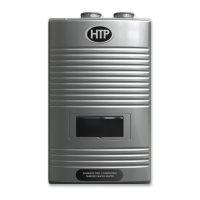17
LP-505 REV. 4.29.14
For sidewall venting, the minimum horizontal distance between adjacent exhaust vent terminations is 1 foot. It is
recommended this distance be greater than 1 foot to better avoid frost damage to building surfaces.
For roof venting, minimum horizontal distance between any adjacent exhaust vent termination is 1 foot.
All joints of positive pressure vent systems must be sealed completely to prevent leakage of flue products into living space.
Remove all burrs and debris from joints and fittings.
When using PVC or CPVC pipe, all joints must be properly cleaned,
primed, and cemented. Use only cement and primer approved for use
with the pipe material. Cement must conform to ASTM D2564 for PVC
and ASTM F493 for CPVC pipe. NOTE: DO NOT CEMENT
POLYPROPYLENE PIPE.
Ensure the vent is located where it will not be exposed to prevailing
winds.
In all roof venting applications, exhaust discharge must point away
from the pitch of the roof.
To prevent water leakage, install adequate roof flashing where the pipe
enters the roof.
Do not locate vent over public walkways, driveways, or parking lots.
Condensate could drip and freeze, resulting in a slip hazard or damage
to vehicles and machinery.
Due to potential moisture build-up, sidewall venting may not be the
preferred venting option. To save time and cost, carefully consider
venting installation and location.
Horizontal lengths of exhaust vent must slope back towards the water
heater not less than ¼" per foot to allow condensate to drain from the
vent pipe.
The exhaust vent must terminate where vapors cannot make accidental contact with people or pets, or damage shrubs or
plants.
In vacant chimney applications, install and seal a rain cap over existing chimney openings.
All piping must be fully supported. Use pipe hangers at a minimum of 4 foot intervals to prevent sagging of the pipe where
condensate may form.
Do not use the water heater to support any piping.

